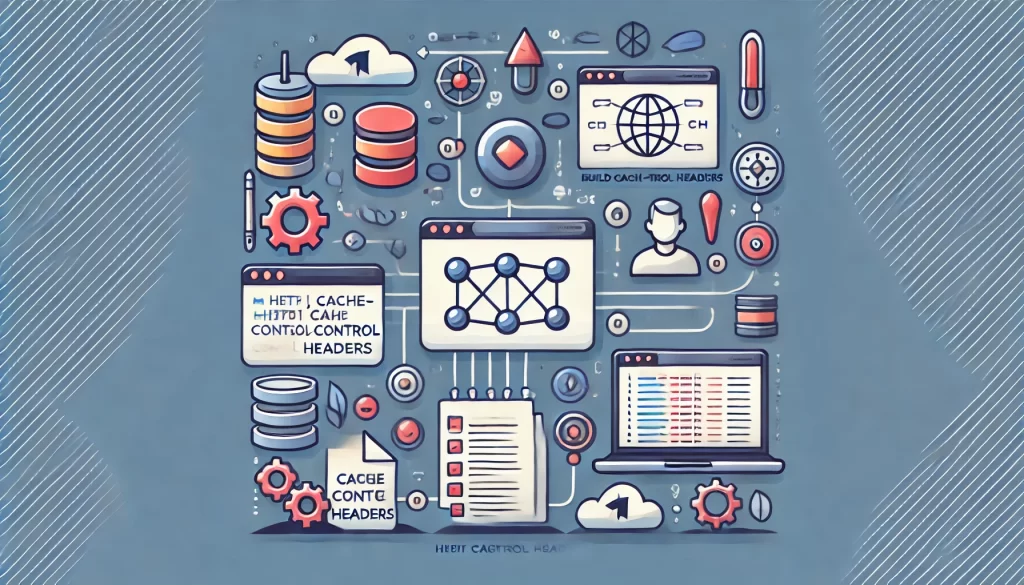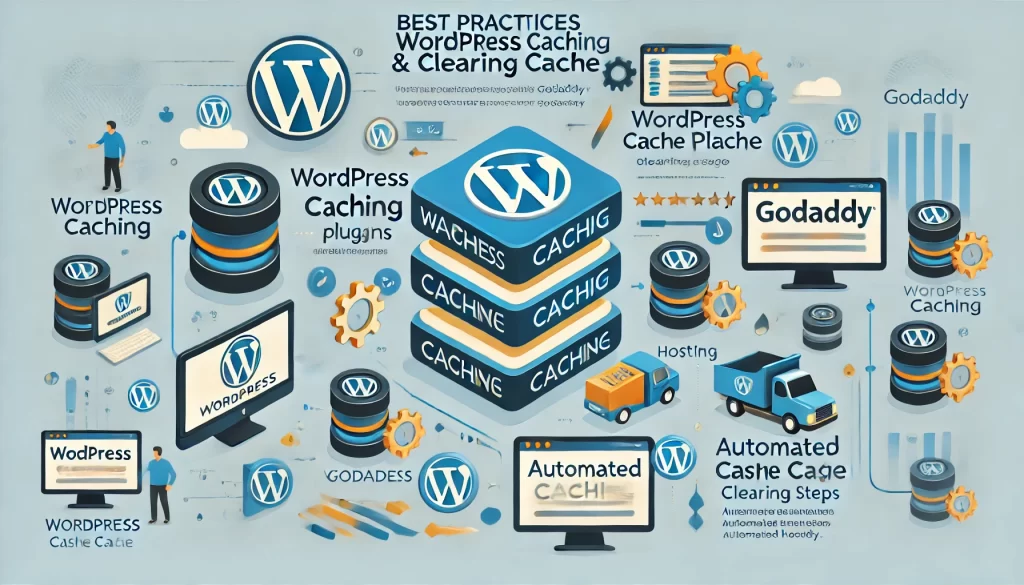Effective cache management is a key component of optimizing website performance and development workflows. Cache helps reduce load times by storing static assets, but when improperly managed, it can lead to outdated content, slow performance, and even system failures. For developers and enterprises, mastering advanced cache management techniques and tools can help avoid these issues while improving user experience. We’ll explore advanced cache management practices, including automating cache clearing, browser extensions, best practices for WordPress caching, and clearing cache using GoDaddy. Let’s dive into how you can make the most of your cache management system.

Automating Cache Clearing for Developers
Manual cache clearing can be time-consuming and inefficient, especially in complex development environments. For developers, automating cache clearing is a game-changer. Automated systems help save time and ensure that outdated cache is removed without needing manual intervention. This is especially useful when deploying new updates, testing, or troubleshooting.
Suggested Posts:
• Firefox Cache Management
• Opera GX and Opera Cache Management
• Caching Concepts and Best Practices
Why Automate Cache Clearing?
The primary benefit of automating cache clearing is time efficiency. Developers often need to clear their cache to see changes in real time, and manual clearing can disrupt their workflow. Automation allows for smoother processes and quicker feedback during development cycles.
- Improved efficiency: Automated systems clear the cache regularly or during specific events (such as new deployments or code changes).
- Error-free workflows: Automation eliminates human error in cache clearing.
- Time-saving: Developers can focus more on coding and less on manually clearing the cache.
How to Automate Cache Clearing?
- Use Build Tools: Popular build tools like Webpack can be configured to automatically clear the cache during deployments. By setting up cache busting, developers can force browsers to fetch the latest resources after every update.
- Cache-Control Headers: Using HTTP Cache-Control headers enables automated cache invalidation. Developers can set these headers to instruct browsers when to fetch updated content.
- Cache Management Scripts: Developers can use custom scripts or third-party tools to clear the cache at specific times, such as after new content is pushed live or after a code push.
By automating cache clearing, developers can streamline their processes, reduce manual errors, and improve development speed.

How Browser Extensions Help Manage Cache
Browser extensions are a powerful tool for cache management. These extensions are especially useful for developers and those testing web performance. Extensions can help quickly clear the cache, block the cache, or force a refresh without having to navigate through browser settings.
Popular Cache Management Extensions
- Clear Cache (Chrome Extension): This lightweight extension allows you to clear cache with a single click. It’s simple and ideal for users who frequently need to clear their cache but don’t want to go through the settings every time.
- Cache Killer (Chrome Extension): Cache Killer is an extension that forces browsers to reload the page without cache. This is useful when you want to see changes on your website immediately during development.
- Clear Cache (Firefox Extension): Similar to the Chrome extension, this one is for Firefox users. It provides a one-click solution for clearing cache, cookies, and other stored data.
- Cache Viewer (Firefox Extension): For those who need to examine the cache before clearing it, Cache Viewer allows you to view what’s stored in your cache. This extension is useful when debugging issues caused by outdated or corrupted cache.
- Web Cache Cleaner (Opera Extension): For Opera users, this extension clears the browser cache and resets browsing data, making it easier to maintain a fast and accurate browsing experience.
Why Use Browser Extensions for Cache Management?
- Convenience: Extensions offer quick access to cache-clearing tools without needing to navigate through menus.
- Customization: Extensions often allow you to set rules or schedules for when and how the cache is cleared.
- Testing: Developers can test websites without cached content, ensuring they see the most recent updates.
By incorporating these extensions into your workflow, you can gain more control over cache management, making it easier to ensure your websites are running smoothly and displaying updated content.
WordPress Browser Caching Best Practices
WordPress is one of the most popular content management systems (CMS), and effective cache management is critical to maintaining fast load times and smooth performance. Browser caching can help WordPress websites reduce the load time by storing static files in users’ browsers.
WordPress Browser Caching Overview
Browser caching in WordPress allows certain files (like CSS, JavaScript, and images) to be stored in the visitor’s browser. The next time the visitor accesses the same website, the browser doesn’t need to reload these files from the server, leading to faster page load times.
Best Practices for WordPress Browser Caching
- Leverage Cache Plugins: Plugins like W3 Total Cache and WP Super Cache are essential for improving WordPress performance. These plugins help you configure browser caching and offer built-in support for caching static content.
- Set Expiration Headers: In WordPress, you can set expiration dates for cached content. This can be done by editing the .htaccess file or using plugins to set cache expiration headers. A typical recommendation is to set a 1-week cache expiry for images and 1-year expiry for static files like fonts and stylesheets.
- Enable GZIP Compression: Enabling GZIP compression can reduce the file size of your content, making it easier and faster for users to download and store cached data.
- Use a Content Delivery Network (CDN): A CDN can store cached versions of your content on servers worldwide. This ensures that users access the cached content from a server geographically closer to them, further reducing load times.
- Minimize Cache Fragmentation: Caching dynamic content can be tricky in WordPress, especially if your site contains user-specific data. By using Varnish Cache or Redis for object caching, you can avoid cache fragmentation and ensure that users receive accurate, up-to-date content without unnecessary delays.
By following these best practices, WordPress site owners can significantly reduce server load, improve page speed, and enhance the overall user experience.
Suggested Posts:
• The Ultimate Guide to Browser Caching
• Cross-Browser Cache Management
• FAQs and Community Resources for Cache Management
Using GoDaddy to Clear Cache and Cookies
GoDaddy is one of the leading web hosting providers, and they offer various tools to manage cache and cookies. Many users host WordPress sites on GoDaddy, so it’s essential to understand how to clear the cache to maintain optimal performance.
How to Clear Cache Using GoDaddy
- Clear Browser Cache: Log into your GoDaddy account and access your website’s cPanel or dashboard. From here, you can manage cache settings. GoDaddy often caches content to improve load times, but this cached data can cause outdated information to appear.
- Use GoDaddy’s Cache Settings: GoDaddy offers Website Caching options in cPanel, allowing you to clear or adjust cache settings. By clearing the cache here, you can ensure that your website visitors receive the latest version of your site.
- Cookies Management: While GoDaddy doesn’t directly manage cookies, you can clear your cookies manually through your browser settings. Cookies can store session data, and clearing them ensures a fresh start for your website.
- Clear Server Cache: Some GoDaddy hosting plans offer automatic caching to optimize performance. You can clear server-side caches from the hosting control panel by going to the caching section and selecting Clear Cache.
Why Use GoDaddy for Cache Management?
GoDaddy’s integrated tools allow you to manage cache without relying on third-party plugins or complex configurations. Their straightforward interface makes it easy for site owners to ensure that they are serving the most current data to users.
FAQs About Advanced Cache Management
1. What is cache management?
Cache management refers to controlling and optimizing how cached data is stored, updated, and served by browsers, servers, and web applications.
2. How can I automate cache clearing?
You can automate cache clearing by using build tools like Webpack, setting cache-control headers, or creating custom scripts that run automatically during deployment or code changes.
3. What tools help manage cache effectively?
Browser extensions like Clear Cache, Cache Killer, and Cache Viewer help manage cache quickly and easily. Additionally, caching plugins and tools like W3 Total Cache or GoDaddy’s caching options can optimize website performance.
4. How does WordPress handle caching?
WordPress relies on plugins to manage caching. By setting proper expiration headers and using CDNs, WordPress websites can significantly reduce page load times and server load.
5. What is the best way to manage cache in an enterprise setting?
In an enterprise setting, using CDN networks, caching plugins, and server-side caching tools like Redis or Varnish can help manage cache efficiently. Automating cache clearing and using build tools can further streamline the process.
6. Can GoDaddy manage my website’s cache?
Yes, GoDaddy offers caching tools within their hosting plans that allow you to manage and clear cache directly from the hosting control panel.
Key Takeaways
Advanced cache management is essential for improving website performance, user experience, and development workflows. By automating cache clearing, using browser extensions, and following best practices for WordPress and GoDaddy, developers and enterprises can ensure their websites run efficiently and without issues. Mastering cache management will save time, enhance user experience, and keep your web applications fast and up-to-date.
- Automating cache clearing saves developers time and ensures that outdated cache does not disrupt workflows.
- Browser extensions like Clear Cache and Cache Killer offer quick, one-click solutions for managing cache during development.
- WordPress caching best practices include using plugins, setting expiration headers, and leveraging CDNs to reduce page load times.
- GoDaddy’s caching tools provide a simple and effective way to clear server-side and browser cache without additional plugins.
With the right tools and techniques, cache management can be made simple and effective. Stay on top of your cache strategy to ensure your websites and applications perform at their best.